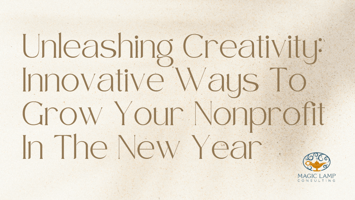Nonprofit organizations are dedicated to tackling pressing societal issues; they rely on the trust...
Creating a Culture of Innovation in Your Nonprofit: Fostering Creativity and Agility for Greater Impact

Innovation is often associated with the private sector, but it’s just as critical for nonprofits. In a world where social challenges are increasingly complex, nonprofits must continuously evolve to meet the changing needs of the communities they serve. Creating a culture of innovation can help organizations remain adaptable, responsive, and impactful.
Building an environment that fosters creativity and agility within a nonprofit requires more than just adopting new technologies or launching cutting-edge programs. It’s about cultivating an organizational mindset that encourages experimentation, values new ideas, and embraces change. This blog explores the importance of innovation in the nonprofit sector and outlines key strategies for creating a culture of creativity and agility within your organization.
The Importance of Innovation in Nonprofits
Nonprofits often operate in resource-constrained environments, making it easy to rely on tried-and-true methods. However, the world is changing rapidly. Shifts in technology, donor expectations, and social issues demand new approaches. Innovation allows nonprofits to:
- Increase efficiency: New tools and processes can streamline operations, allowing your organization to do more with limited resources.
- Maximize impact: Innovative approaches can amplify your ability to deliver services, engage stakeholders, and achieve your mission.
- Attract new donors and partners: Funders and supporters are increasingly drawn to organizations that demonstrate forward-thinking and creative solutions to social challenges.
- Adapt to change: The ability to pivot quickly when faced with new challenges or opportunities is essential for long-term sustainability.
Building a culture of innovation empowers nonprofits to remain relevant, resilient, and effective, even in the face of uncertainty.
1. Empowering Leadership: Leading with Vision and Flexibility
A culture of innovation starts at the top. Leaders must champion creativity and agility by demonstrating openness to new ideas and creating space for experimentation. When leaders encourage innovative thinking, employees feel more empowered to take risks and propose bold solutions.
How to Implement:
- Model innovative behavior: Leaders should embrace change and be willing to take calculated risks. This signals to the rest of the organization that innovation is a priority.
- Foster a shared vision: Communicate a clear vision for the organization’s future that inspires creativity. When staff understand the broader goals and mission, they’re more likely to think critically about how to innovate within that framework.
- Support a flexible mindset: Encourage an agile approach to problem-solving by promoting adaptability and openness to change. This includes being willing to pivot when necessary and learning from failures.
2. Encouraging Experimentation: Embracing Risk and Failure
Innovation thrives in environments where experimentation is encouraged, and failure is viewed as part of the learning process. Nonprofits can become risk-averse due to limited resources and tight budgets, but avoiding risk entirely can stifle creativity and limit growth.
How to Implement:
- Create a “fail-forward” culture: Encourage team members to experiment with new ideas and approaches, even if there’s a risk of failure. When failures happen, view them as learning opportunities. Celebrate the effort and reflect on what can be improved.
- Pilot new ideas: Launch small-scale pilot programs to test new ideas before fully committing to them. This allows your organization to explore innovative solutions without significant upfront investment.
- Iterate and adapt: Foster a mindset of continuous improvement. After each pilot or experiment, evaluate the results, gather feedback, and refine your approach based on what you’ve learned.
3. Collaborative Innovation: Leveraging Diverse Perspectives
Innovation is often the result of collaboration and the cross-pollination of ideas. Encouraging collaboration across departments, with external partners, or even with beneficiaries can lead to fresh perspectives and new solutions.
How to Implement:
- Cross-functional teams: Form teams with members from different areas of the organization to brainstorm and solve problems together. Diversity of thought leads to more creative and comprehensive solutions.
- Engage stakeholders: Involve beneficiaries, community members, and donors in the innovation process. Their insights and experiences can help your organization develop more relevant and effective programs.
- Partner with other organizations: Collaborate with other nonprofits, businesses, or academic institutions to share knowledge, resources, and innovative practices.
4. Building Capacity for Innovation: Investing in Skills and Tools
To foster a culture of innovation, nonprofits must invest in the skills and tools that enable creativity and agility. This includes training staff to think critically, use new technologies, and stay informed about trends in the sector.
How to Implement:
- Training and professional development: Offer workshops or courses that help staff develop skills in areas such as design thinking, data analysis, and project management. Equip them with the tools they need to think innovatively.
- Adopt new technologies: Invest in tools that streamline operations, enhance communication, and improve data collection. Digital tools, such as project management platforms or data analytics software, can provide new insights and increase efficiency.
- Encourage continuous learning: Foster a culture of learning by encouraging staff to stay up to date on trends and best practices in the nonprofit sector. Regularly share articles, attend webinars, and engage in discussions about new approaches.
5. Recognizing and Rewarding Innovation: Celebrating Creativity
Creating a culture of innovation requires recognizing and rewarding those who contribute to it. When employees feel that their creative efforts are valued and celebrated, they’re more likely to continue pushing boundaries and seeking out new ideas.
How to Implement:
- Recognize creative contributions: Publicly acknowledge team members who propose innovative solutions or take initiative in problem-solving. Recognition can come in the form of awards, shout-outs in meetings, or even small incentives.
- Celebrate successes: When an innovative project or idea leads to a breakthrough, celebrate the success with the entire organization. This reinforces the value of innovation and motivates others to contribute.
- Create innovation challenges: Encourage staff to participate in challenges or hackathons where they can propose new ideas or solutions to pressing problems. Offer rewards for the most creative and impactful ideas.
6. Fostering Agility: Staying Adaptable in a Changing World
In addition to creativity, a culture of innovation requires agility—the ability to respond quickly and effectively to changes in the external environment. Agility allows nonprofits to pivot when necessary and seize new opportunities as they arise.
How to Implement:
- Responsive decision-making: Empower teams to make decisions quickly without excessive layers of approval. This helps your organization respond to opportunities or challenges in real-time.
- Agile project management: Implement agile methodologies such as Scrum or Kanban to manage projects more flexibly. These approaches emphasize iterative development, collaboration, and adaptability.
- Scenario planning: Engage in scenario planning to prepare for potential changes in your operating environment. By thinking ahead, your organization can develop contingency plans and remain agile when faced with uncertainty.




